Body composition analysis is becoming a standard tool that is being used by fitness experts, coaches, and healthcare professionals.

In 2019 we can discard reliance on body mass index (BMI) as a means to measure health.
Other than our appearance, there is a list of diseases associated with obesity. This is what’s at the top of our minds. The list is long, and includes heart disease, hypertension, cancer, joint problems, dementia, and diabetes.
Body composition analysis is defined as the clinical assessment of tissue and fluid in the human body.
- Fat Mass
- Fat-Free Mass
- Body Cell Mass
- Extracellular Mass
- Total Body H2O
- Intracellular H2O
- Extracellular H2O
Normal distribution of tissue and fluid is associated with immunity, high function, and longevity.
However, not being able to have detailed insight into your personal body composition can lead to critical errors in understanding what’s going on, along with recommendations. This can hinder the ability to reach a specific fitness goal.
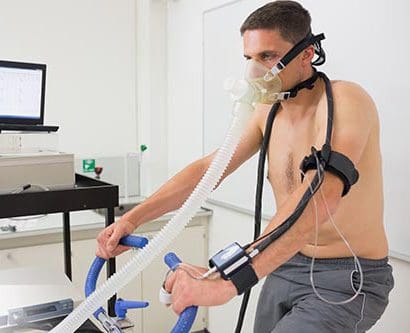
Body composition analysis is utilized in preventative, therapeutic, and research applications.
- Nutrition
- Anti-Aging
- Physical Performance Assessment
- Weight Management
- Geriatrics
- Lifestyles Assessment
- Athletic Performance
To perform body composition analysis, mass and fluid are modeled, measurements taken, and results analyzed.
Bioimpedance (BIA) body composition analyzers measure body composition electronically. However, they do not, diagnose disease, or calculate treatment options. Only qualified health care professionals can diagnose and recommend treatment options.
There are concerns that affect everyone, which is why knowledge of body composition is important for your health in 2019 onward.

Table of Contents
Model Body
Look at the images below of six males, all of whom are 5′ 9″ and 170 pounds. There could be some envy from their 25.4 BMI, as the results are come up on the computer screen. However, looking at the actual patient or their scans using today’s technology, the results are pretty revealing.
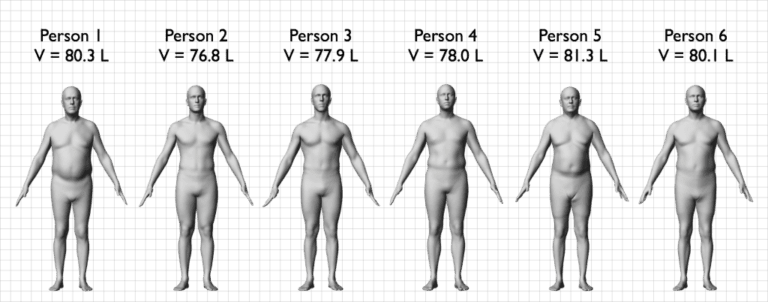
Notice the difference in the midsection, where there is an abnormal accumulation of visceral fat.
This occurs in metabolic syndrome and what is known as A
- Fat Mass (FM): Total amount of stored lipids in the body and consists of the following types:
- Subcutaneous Fat is located right under the skin. Subcutaneous fat functions as an energy reserve and as insulation from the cold.
- Visceral Fat is located deeper in the body. This fat serves as an energy reserve and as a cushion between the organs.
- Fat-Free Mass (FFM), aka Lean Body Mass (LBM): Total amount of nonfat (lean) parts of the body.
- Consists of approximately 73% water, 20% protein, 6% mineral, and 1% ash.
- Fat-free mass divides further into body cell mass and extracellular mass:
- Body Cell Mass (BCM): All the metabolically active tissues (cells) of the body, which include muscle, organ, blood, and immune cells.
- BCM includes the “living” portion of fat cells, but not fat lipids.
- BCM also includes H2O inside living cells. This water is called Intracellular Water (ICW). The main electrolyte is potassium.
- Extracellular Mass (ECM): All the metabolically inactive (non-living) parts of the body, such as bone minerals and blood plasma. ECM includes water contained outside living cells. This water is called Extracellular Water (ECW). The main electrolyte is sodium.
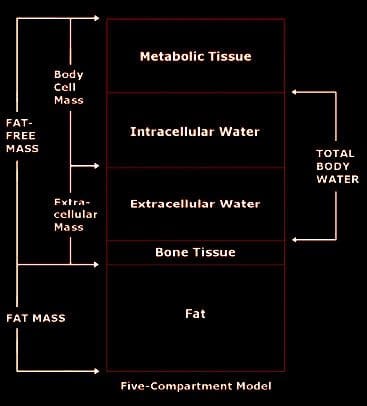
Composition & Body Health
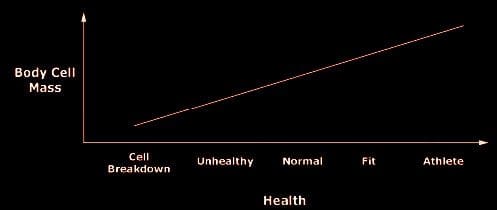
- Body composition correlates directly to maintained proper health, that range from mortality/morbidity to immunity, longevity, high function, and athletic performance.
- Body composition analysis’ purpose is to monitor and improve function.
- Healthy patients analysis of fat-free mass and body cell mass helped maintain function, productivity, immunity, physical performance, and longevity.
Every case is different but through body composition analysis, people can have a better understanding of their body, what options are available to them, and most importantly do not have to be on medication/s for the rest of their lives.

References:
- Kyle UG, et al. Physical activity and fat-free and fat mass by bioelectrical impedance in 3853 adults. Medicine and Science in Sports and Exercise, 2001;33:576-584.
- Mattar JA, et al. Application of total body bioimpedance to the critically ill patient. New Horizons, 1995, Vol 4., No. 4; 493-503.
- Ott M, et al. Bioelectrical impedance analysis as a predictor of survival in patients with human immunodeficiency virus infection. Journal of Acquired Immune Deficiency Syndromes and Human Retrovirology, 1995; 9:20-25.
Post Disclaimer
Professional Scope of Practice *
The information herein on "BIA Testing: Body Composition Analysis | El Paso, TX." is not intended to replace a one-on-one relationship with a qualified health care professional or licensed physician and is not medical advice. We encourage you to make healthcare decisions based on your research and partnership with a qualified healthcare professional.
Blog Information & Scope Discussions
Welcome to El Paso's Premier Wellness, Personal Injury Care Clinic & Wellness Blog, where Dr. Alex Jimenez, DC, FNP-C, a Multi-State board-certified Family Practice Nurse Practitioner (FNP-BC) and Chiropractor (DC), presents insights on how our multidisciplinary team is dedicated to holistic healing and personalized care. Our practice aligns with evidence-based treatment protocols inspired by integrative medicine principles, similar to those found on this site and our family practice-based chiromed.com site, focusing on restoring health naturally for patients of all ages.
Our areas of multidisciplinary practice include Wellness & Nutrition, Chronic Pain, Personal Injury, Auto Accident Care, Work Injuries, Back Injury, Low Back Pain, Neck Pain, Migraine Headaches, Sports Injuries, Severe Sciatica, Scoliosis, Complex Herniated Discs, Fibromyalgia, Chronic Pain, Complex Injuries, Stress Management, Functional Medicine Treatments, and in-scope care protocols.
Our information scope is multidisciplinary, focusing on musculoskeletal and physical medicine, wellness, contributing etiological viscerosomatic disturbances within clinical presentations, associated somato-visceral reflex clinical dynamics, subluxation complexes, sensitive health issues, and functional medicine articles, topics, and discussions.
We provide and present clinical collaboration with specialists from various disciplines. Each specialist is governed by their professional scope of practice and their jurisdiction of licensure. We use functional health & wellness protocols to treat and support care for musculoskeletal injuries or disorders.
Our videos, posts, topics, and insights address clinical matters and issues that are directly or indirectly related to our clinical scope of practice.
Our office has made a reasonable effort to provide supportive citations and has identified relevant research studies that support our posts. We provide copies of supporting research studies upon request to regulatory boards and the public.
We understand that we cover matters that require an additional explanation of how they may assist in a particular care plan or treatment protocol; therefore, to discuss the subject matter above further, please feel free to ask Dr. Alex Jimenez, DC, APRN, FNP-BC, or contact us at 915-850-0900.
We are here to help you and your family.
Blessings
Dr. Alex Jimenez DC, MSACP, APRN, FNP-BC*, CCST, IFMCP, CFMP, ATN
email: coach@elpasofunctionalmedicine.com
Multidisciplinary Licensing & Board Certifications:
Licensed as a Doctor of Chiropractic (DC) in Texas & New Mexico*
Texas DC License #: TX5807, Verified: TX5807
New Mexico DC License #: NM-DC2182, Verified: NM-DC2182
Multi-State Advanced Practice Registered Nurse (APRN*) in Texas & Multi-States
Multistate Compact APRN License by Endorsement (42 States)
Texas APRN License #: 1191402, Verified: 1191402 *
Florida APRN License #: 11043890, Verified: APRN11043890 *
License Verification Link: Nursys License Verifier
* Prescriptive Authority Authorized
ANCC FNP-BC: Board Certified Nurse Practitioner*
Compact Status: Multi-State License: Authorized to Practice in 40 States*
Graduate with Honors: ICHS: MSN-FNP (Family Nurse Practitioner Program)
Degree Granted. Master's in Family Practice MSN Diploma (Cum Laude)
Dr. Alex Jimenez, DC, APRN, FNP-BC*, CFMP, IFMCP, ATN, CCST
My Digital Business Card
RN: Registered Nurse
APRNP: Advanced Practice Registered Nurse
FNP: Family Practice Specialization
DC: Doctor of Chiropractic
CFMP: Certified Functional Medicine Provider
MSN-FNP: Master of Science in Family Practice Medicine
MSACP: Master of Science in Advanced Clinical Practice
IFMCP: Institute of Functional Medicine
CCST: Certified Chiropractic Spinal Trauma
ATN: Advanced Translational Neutrogenomics


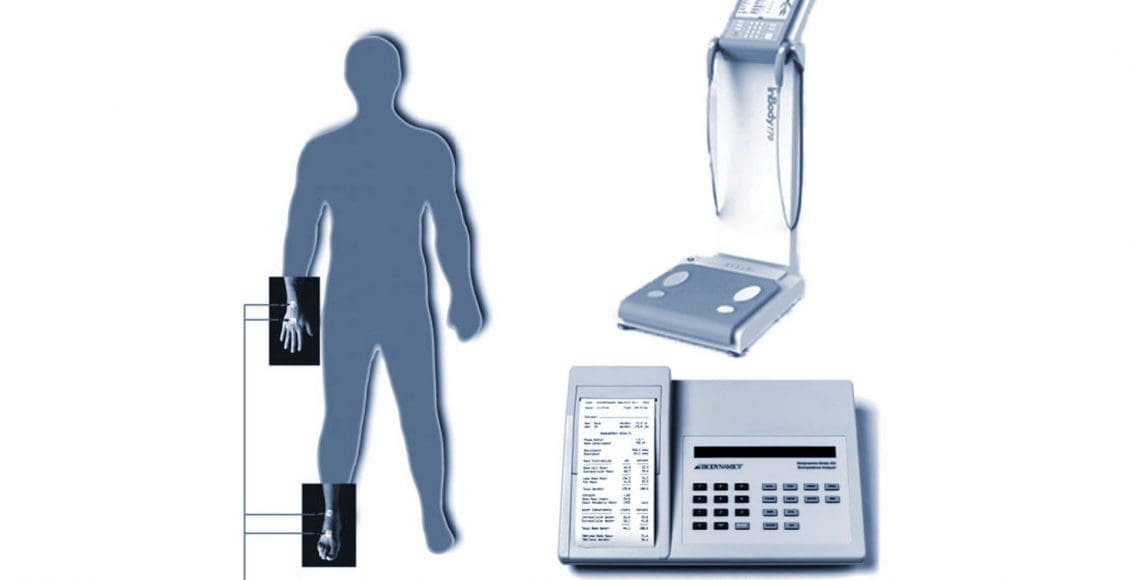


 Again, We Welcome You.
Again, We Welcome You.
Comments are closed.